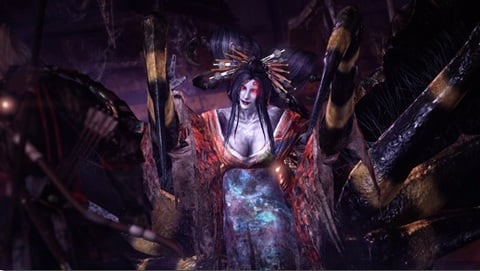In recent years, it seems that some developers are deciding to take inspiration from From Software’s Dark Souls series. With titles such as Lords of the Fallen, Salt and Sanctuary, and Let It Die, it seems that the Souls games are becoming more of a genre than a trend. Team Ninja had no intention of ignoring their love of the Souls franchise while promoting Nioh. They made it well known that Dark Souls and Bloodborne were sort of a template on how they approached development. Nioh is challenging. Nioh is frustrating. Yet, just like the Souls games, the thrill of victory makes it all worth it. It’s still its own full-fledged game with it’s own identity and, hopefully, the start of a new franchise. To put this into perspective: it’s got the difficulty of a From Software title, but with the combat of titles such as Ninja Gaiden and Onimusha. With all that being said, Nioh is much more than just “Dark Souls with samurai and ninjas” (although that really does sound awesome enough).
Nioh takes players on a journey through 16th century Japan during the Sengoku period. Players take on the role of real-life sailor William Adams (bearing a huge resemblance to The Witcher‘s Geralt of Rivia), who is known as the world’s first Western Samurai. While Nioh is set during a very interesting time in history, it’s a fantasy at heart, using the historical context as a backdrop for the story.
Nioh’s adventure sets Adams on a journey through a war-torn and Yokai (basically demons) infested Japan to recover a mystical power known as Amrita. Queen Elizabeth had originally sent Adams on a voyage to recover Amrita in order to secure a victory over Spain. Unfortunately, a man named Edward Kelley has sought out to take the relic for himself. Adam’s mission becomes a race to the finish before Kelley can claim the Amrita for himself. Nioh’s fantasy spin on Japanese history doesn’t take itself too seriously either, which is refreshing and kept me invested enough thanks to a colorful cast of side characters. In a game that can be absolutely brutal, the quirkiness of its narrative becomes a sigh of relief. Nioh’s narrative isn’t great, but I wouldn’t say it’s bad either. It’s kind of just there to give players feeling some sort of purpose and reason for doing what they’re doing.

When it comes to visuals, Nioh offers different game modes for the PS4 and PS4 Pro; I did this review on a regular PS4. There is Movie Mode, which holds the most crisp textures and detail in 1080p, but stuck at 30 fps. Action Mode, which stayed at around 720p, but offers 60 fps and rarely ever dropped. Finally, the last one is Variable Movie Mode, which is a combination of both. Personally, I recommend playing this on Action Mode due to the fast paced nature of the combat. It’s easy to go from Movie Mode to Action Mode, but going vice versa isn’t fun. I started the game in Action Mode, and once I decided to test out Movie Mode, I was thrown off. That is only due to the drop in framerate that I had to endure. While I appreciated the enhanced slick visuals, it was not enough at the cost of a lower framerate. Variable Movie Mode is really just there to find equilibrium, but it just felt all over the place. Variable framerates constantly changing just took a toll on my eyes. So please stick to Action Mode as it’s a much better experience.
While traversing through the many different environments that Nioh has to offer, I ended up loving the level design the more I played. Instead of taking the full open-world approach that the Souls games have, Nioh instead gives players self-contained missions to choose from each region, each offering rewards that players know from the start. On top of the main missions, there are sub missions, which vary in terms of completion. Some can be only a boss fight, while others become an arena style mission. At first I was worried about this, due to my love of From Software’s intricately connected environments. However, it eventually grew on me as each mission’s map had its own set of objectives and creates its own aesthetic.
From cold and snowy environments to a ninja-filled mansion laced with traps and secret doors, there’s no shortage of variety in levels to explore (and die in). Levels always have a few shrines (Like Soul’s bonfires), however they are rare throughout, causing the player to look for many shortcuts instead. Nioh requires exploration. In order to succeed throughout the game, it is incredibly necessary to find every nook and cranny in the level in order to find the best loot and also the adorable little green Kodama tree spirits. Finding these spirits grant the player more healing elixirs that are automatically filled through each respawn. Anyone who is a completionist will absolutely love this attention to detail in each level.

What stands out to me was just how in-depth Nioh’s systems are. There are so many mechanics that the player needs to keep track of, almost to the point where I almost forgot I had points for certain upgrades. Quite honestly it was intimidating at first as there were so many things I needed to understand, but then again, aren’t most great RPGs intimidating in the beginning? Luckily, Nioh offers helpful tutorials throughout. There’s more to it than the usual leveling up my character and upgrading my gear. Skill points can be used for weapons, weapons have a familiarity scale, and players can even earn Prestige points adding bonuses to their overall stats. The more I played, the better my inherently character got. Constantly feeling productive in my character kept me addicted for hours on end.
Nioh’s loot system is something that will leave some players conflicted. I couldn’t grow too attached to one particular weapon or piece of armor, as there is an over-abundance of loot. Enemies will constantly drop gear that is often slightly better than something I already had equipped. Fortunately, Nioh’s Soul Matching system adds a new dynamic to this, giving the player the ability to take a lower level item and match it with something higher, thus increasing the stats to the correct level. Only downside to this mechanic is that it will sometimes cost a pretty penny, depending on the level or rarity of the item. Other than that, it makes me wish more games utilized this. No one likes finding a great weapon, only to have it be under-leveled a few hours later.
Speaking of weapons, be prepared to try them all. There are 5 different weapon types to choose from, all of which are easily accessible to any playstyle. I started the game off using swords, switched to dual katanas later, then ended the game using mainly spears (FYI: I’ve always hated spears in games, but I absolutely loved spears in Nioh). What I appreciated about the weapons is how each type made me feel like a badass, which is needed as a confidence booster when taking on the game’s toughest enemies. On top of the weapons, there is also the Guardian Spirit, which is always in the form of a certain animal. Summoning a Guardian Spirit when available will cause a weapon to go into its ultimate form with some sort of elemental attack, aptly named a Living Weapon. It will also basically make the player invincible for the time being, so yeah, use it!

Nioh’s combat is the star-child of this game. It’s fast, precise, and overall just a ton of fun. Stances play a huge role in combat: high, middle, and low stance. High stance utilizes more power at the cost of more Ki (basically stamina), middle stance offers more chance to parry, and low stance is all about fast moves and using less Ki. Ki is more important than anything in the combat, as efficient use of it is the difference between life and death. It’s great that the stances cater to anyone’s play style. I’ve always preferred to be a quick warrior in games so I spent a lot of time upgrading my low stance skills. Weapon skills and stances makes the game more than just a hack and slash style title. For example, my spear granted me an ability to jump in the air at the end of a combo and do a plunging attack. My sword was able to unleash a force field that drains enemy stamina. As I said earlier, try out all the weapons, they’re all fun!
You will die. A lot. Just like the Souls games, dying is part of the experience. There are so many mechanics that add the risk/reward factor to them. Should I keep going or decide to level up now? Should I use my guardian spirit for this enemy? Can I take on this boss by myself or should I call in some help? It’s questions like these that make every single encounter in Nioh feel intense and kept me constantly on my toes. It became unfortunate later, however, that the game dropped a lot of the same enemies at the player. Where I would be 20 hours in and run into enemies I was fighting in the beginning of the game. Thus making it easy, because their move sets were already embedded in my head. While enemy designs are unique and grotesque, more variety would’ve been appreciated. That’s not to say they aren’t tough though. The AI is absolutely vicious and will do whatever strategy is necessary to bring you down. Fighting AI-controlled versions of other players who’ve recently died is also a fun feature. When they fight, it sometimes feels as if you are actually fighting another player due to the specific and random actions they take. Killing other player’s summons will also grant the player a chance to take a version of their rare loot.

Now lets get down to the real challenge of the game: the bosses. There are over 20 different and unique bosses that will absolutely demolish any player who isn’t careful. Each one has their own unique move-set and requires patience, but also aggression. My favorite one was at the end of this ninja-filled mansion and defeating it became the most satisfying experience I had throughout the game. He was extremely challenging, but also never unfair. This boss had felt like I truly brought everything I had learned to the table for one epic and intense fight. It’s unfortunate that the game’s final boss is pretty disappointing, as it wasn’t as challenging as I had hoped for the ending. Also, apart from the occasional annoying boss (what game doesn’t have one?), the majority of the bosses are all fun in their own right, no matter how many times they kill me. And when the player is having a rough time, they can call in a co-op partner in Nioh’s simple summoning system.
There is no shortage of content in Nioh. Beating the game can take anyone between 50-70 hours. With all the sub-missions and Twilight missions (harder enemies and better loot) there’s plenty to keep someone occupied for a long time. I’m excited to go back and start a new game utilizing a more Strength heavy character with hammers and axes. Don’t let the difficulty be a reason to not try out this game, as the combat is easy to learn and is brutally satisfying. Who doesn’t want to be a samurai or ninja? For anyone who is a fan of the Souls games, this is an absolute must buy! This game has so much meat to it, especially considering it’s a brand new IP. I can say without a doubt that Nioh is the first great game of 2017, and it’s only February!
If you are thinking of picking up Nioh, I’ve compiled a small list of some helpful hints get you through it:
- Arrows and bullets are powerful, but should only be used occasionally as ammunition isn’t always available. You can’t play the game as an archer
- Don’t use your Guardian Spirit on a boss fight until they have about 25% health left. Don’t use it in the beginning only to possibly die right after, causing you to go kill more enemies in order to recharge it.
- Your Guardian Spirit will reside where you die. You can’t use your Living Weapon if you don’t pick up your Guardian Spirit, unless you call it back, consuming a certain item.
- Pick up everything! If you don’t want it, you can take it for materials or sell it later.
- Try not to take on more than 3 enemies on a time. You aren’t Kratos from God of War
- Don’t underestimate a single enemy. That skinny undead bum can mess you up if you let him
- Switch stances when your enemies do, as some work better with certain enemies. Fast combat works great on the larger foes.
For more information, check out the official listing on Playstation’s website.





